Intercultural Issues in Business Management: Strategies for Success
VerifiedAdded on 2021/02/18
|10
|3171
|37
Essay
AI Summary
This essay delves into the complexities of intercultural issues in business management, highlighting their significant impact on organizational performance, employee relations, and overall business success. It examines the challenges posed by cultural differences, conflicts, and the importance of maintaining employee dignity within a diverse workplace. The essay explores the theoretical framework of Hofstede's cultural dimensions, providing a valuable tool for understanding and navigating cross-cultural communication. It also analyzes the consequences of neglecting employee dignity and diversity, such as increased costs, decreased productivity, and high staff turnover. The essay emphasizes the need for proactive management strategies, including open communication, fair policies, and cultural mentoring to mitigate intercultural issues and foster a positive, productive work environment. The argumentation section presents various perspectives on the advantages and disadvantages of workplace diversity, drawing on research to support its claims. Ultimately, the essay underscores the critical role of effective intercultural management in achieving business goals and fostering a harmonious workplace.
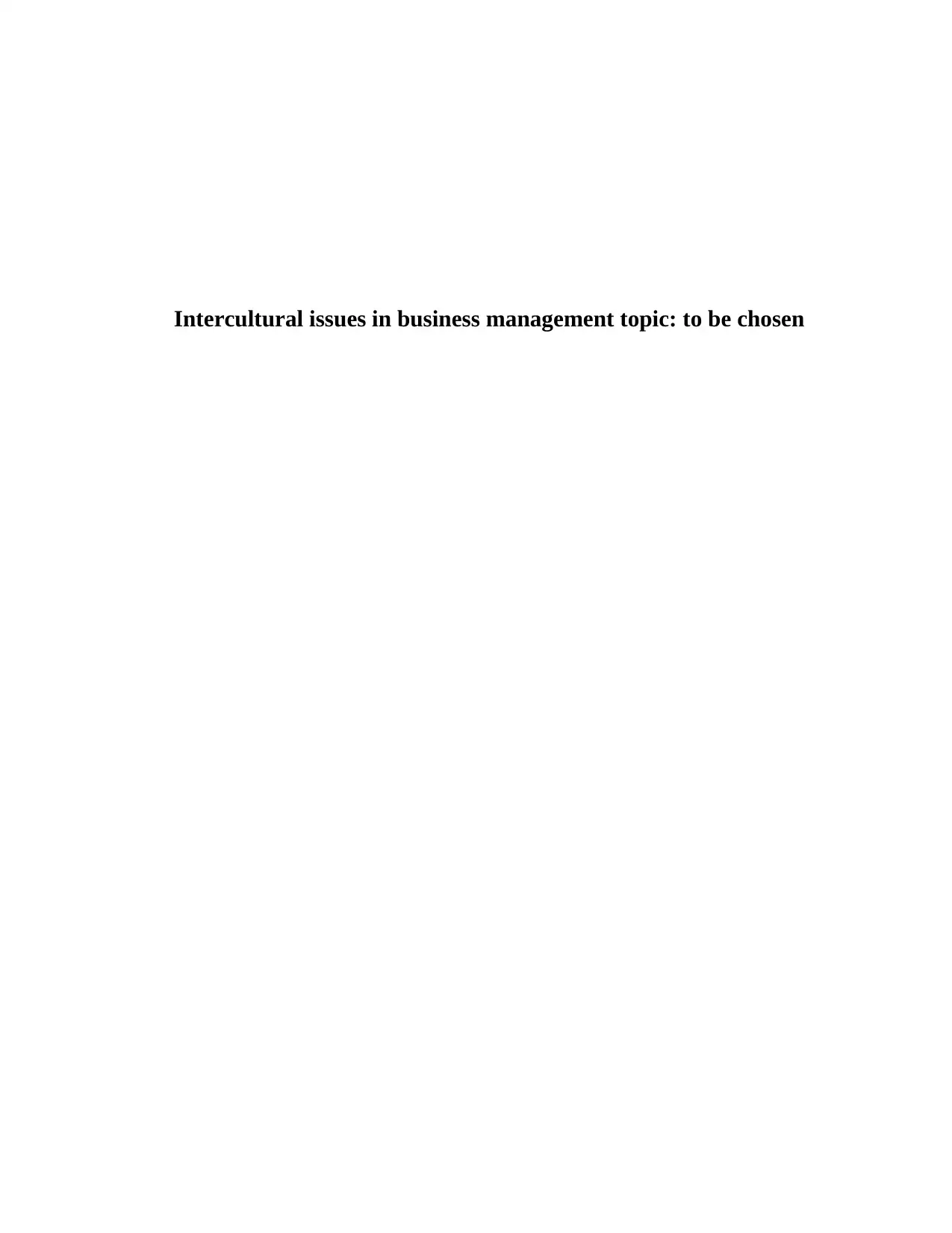
Intercultural issues in business management topic: to be chosen
Paraphrase This Document
Need a fresh take? Get an instant paraphrase of this document with our AI Paraphraser
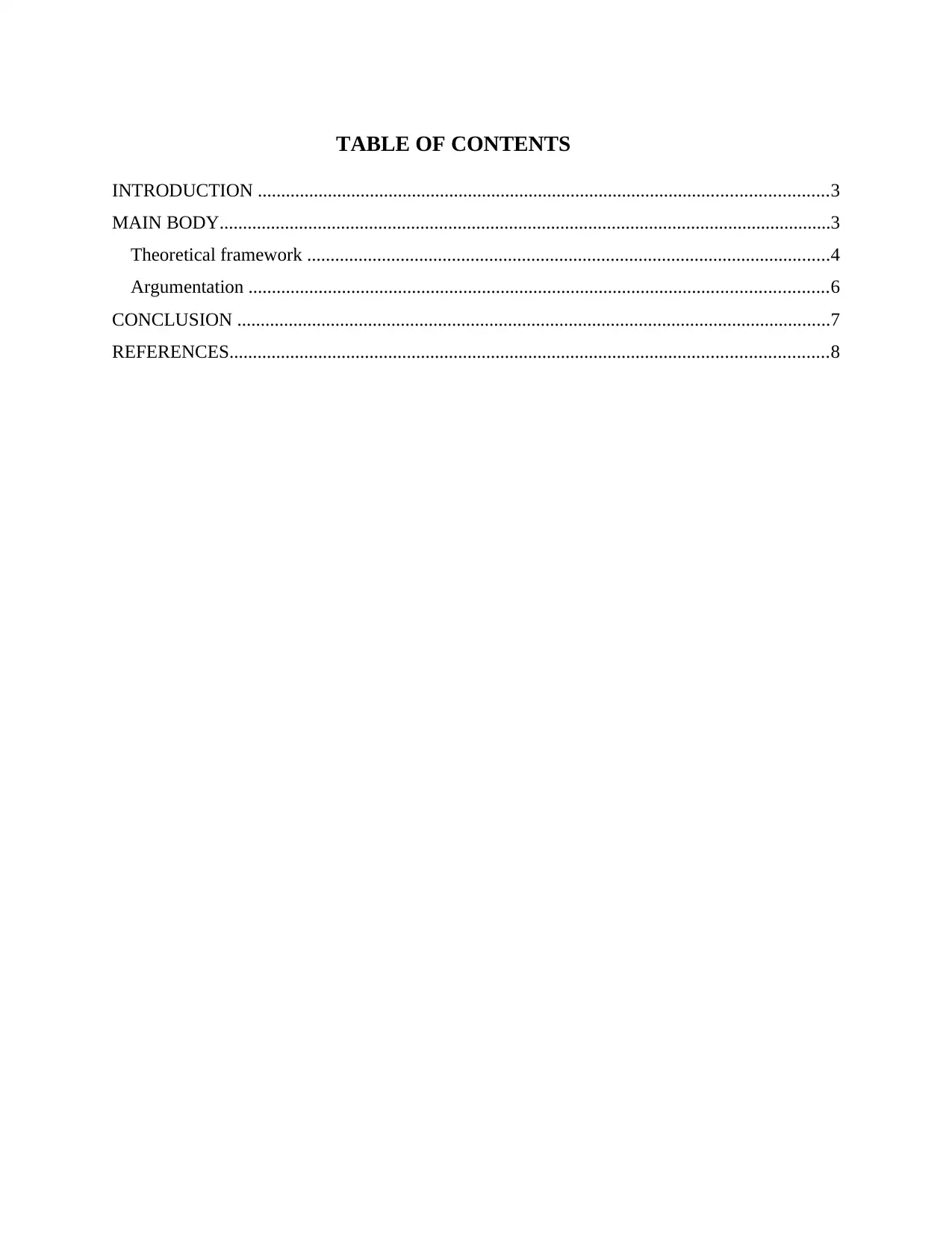
TABLE OF CONTENTS
INTRODUCTION ..........................................................................................................................3
MAIN BODY...................................................................................................................................3
Theoretical framework ................................................................................................................4
Argumentation ............................................................................................................................6
CONCLUSION ...............................................................................................................................7
REFERENCES................................................................................................................................8
INTRODUCTION ..........................................................................................................................3
MAIN BODY...................................................................................................................................3
Theoretical framework ................................................................................................................4
Argumentation ............................................................................................................................6
CONCLUSION ...............................................................................................................................7
REFERENCES................................................................................................................................8
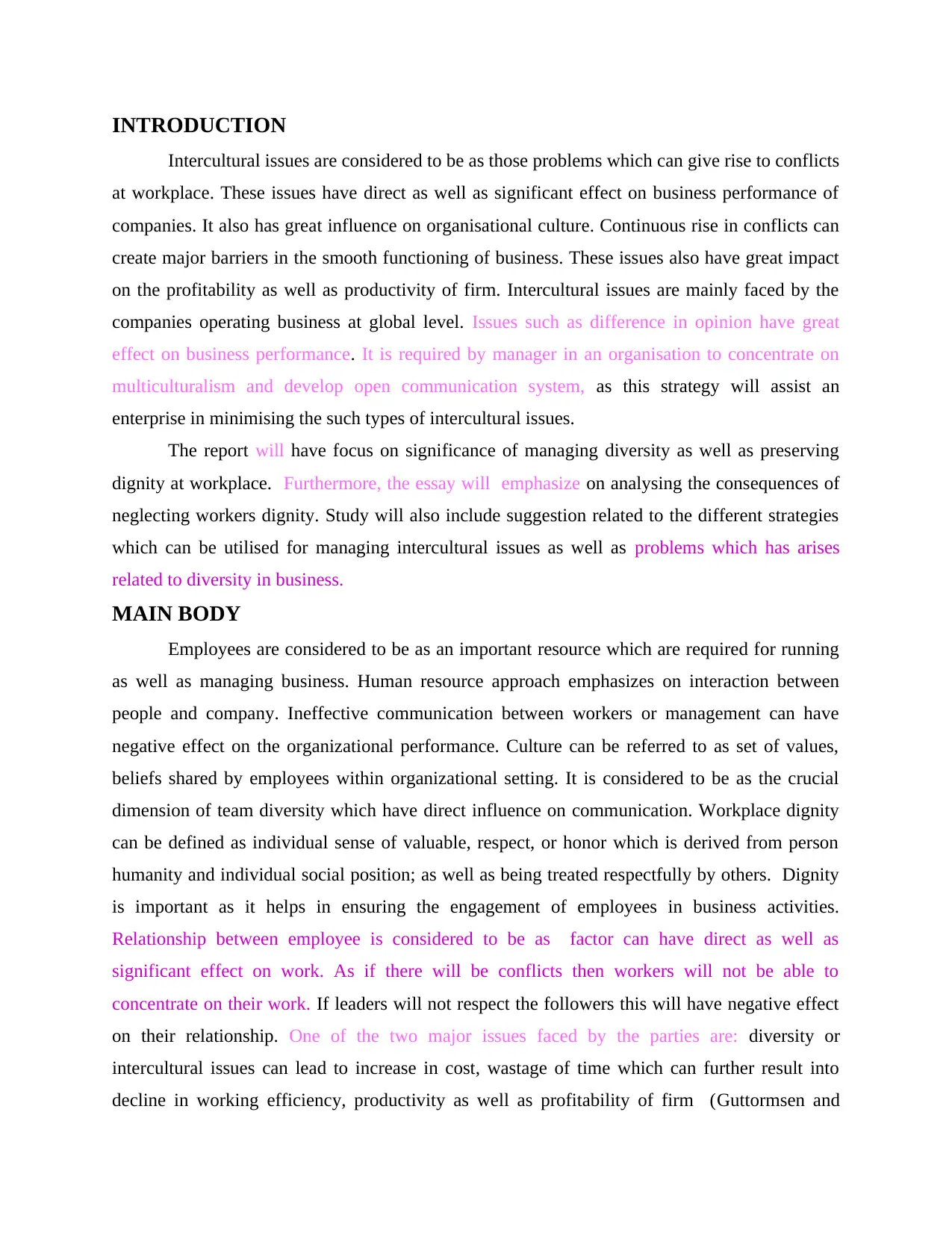
INTRODUCTION
Intercultural issues are considered to be as those problems which can give rise to conflicts
at workplace. These issues have direct as well as significant effect on business performance of
companies. It also has great influence on organisational culture. Continuous rise in conflicts can
create major barriers in the smooth functioning of business. These issues also have great impact
on the profitability as well as productivity of firm. Intercultural issues are mainly faced by the
companies operating business at global level. Issues such as difference in opinion have great
effect on business performance. It is required by manager in an organisation to concentrate on
multiculturalism and develop open communication system, as this strategy will assist an
enterprise in minimising the such types of intercultural issues.
The report will have focus on significance of managing diversity as well as preserving
dignity at workplace. Furthermore, the essay will emphasize on analysing the consequences of
neglecting workers dignity. Study will also include suggestion related to the different strategies
which can be utilised for managing intercultural issues as well as problems which has arises
related to diversity in business.
MAIN BODY
Employees are considered to be as an important resource which are required for running
as well as managing business. Human resource approach emphasizes on interaction between
people and company. Ineffective communication between workers or management can have
negative effect on the organizational performance. Culture can be referred to as set of values,
beliefs shared by employees within organizational setting. It is considered to be as the crucial
dimension of team diversity which have direct influence on communication. Workplace dignity
can be defined as individual sense of valuable, respect, or honor which is derived from person
humanity and individual social position; as well as being treated respectfully by others. Dignity
is important as it helps in ensuring the engagement of employees in business activities.
Relationship between employee is considered to be as factor can have direct as well as
significant effect on work. As if there will be conflicts then workers will not be able to
concentrate on their work. If leaders will not respect the followers this will have negative effect
on their relationship. One of the two major issues faced by the parties are: diversity or
intercultural issues can lead to increase in cost, wastage of time which can further result into
decline in working efficiency, productivity as well as profitability of firm (Guttormsen and
Intercultural issues are considered to be as those problems which can give rise to conflicts
at workplace. These issues have direct as well as significant effect on business performance of
companies. It also has great influence on organisational culture. Continuous rise in conflicts can
create major barriers in the smooth functioning of business. These issues also have great impact
on the profitability as well as productivity of firm. Intercultural issues are mainly faced by the
companies operating business at global level. Issues such as difference in opinion have great
effect on business performance. It is required by manager in an organisation to concentrate on
multiculturalism and develop open communication system, as this strategy will assist an
enterprise in minimising the such types of intercultural issues.
The report will have focus on significance of managing diversity as well as preserving
dignity at workplace. Furthermore, the essay will emphasize on analysing the consequences of
neglecting workers dignity. Study will also include suggestion related to the different strategies
which can be utilised for managing intercultural issues as well as problems which has arises
related to diversity in business.
MAIN BODY
Employees are considered to be as an important resource which are required for running
as well as managing business. Human resource approach emphasizes on interaction between
people and company. Ineffective communication between workers or management can have
negative effect on the organizational performance. Culture can be referred to as set of values,
beliefs shared by employees within organizational setting. It is considered to be as the crucial
dimension of team diversity which have direct influence on communication. Workplace dignity
can be defined as individual sense of valuable, respect, or honor which is derived from person
humanity and individual social position; as well as being treated respectfully by others. Dignity
is important as it helps in ensuring the engagement of employees in business activities.
Relationship between employee is considered to be as factor can have direct as well as
significant effect on work. As if there will be conflicts then workers will not be able to
concentrate on their work. If leaders will not respect the followers this will have negative effect
on their relationship. One of the two major issues faced by the parties are: diversity or
intercultural issues can lead to increase in cost, wastage of time which can further result into
decline in working efficiency, productivity as well as profitability of firm (Guttormsen and
⊘ This is a preview!⊘
Do you want full access?
Subscribe today to unlock all pages.

Trusted by 1+ million students worldwide
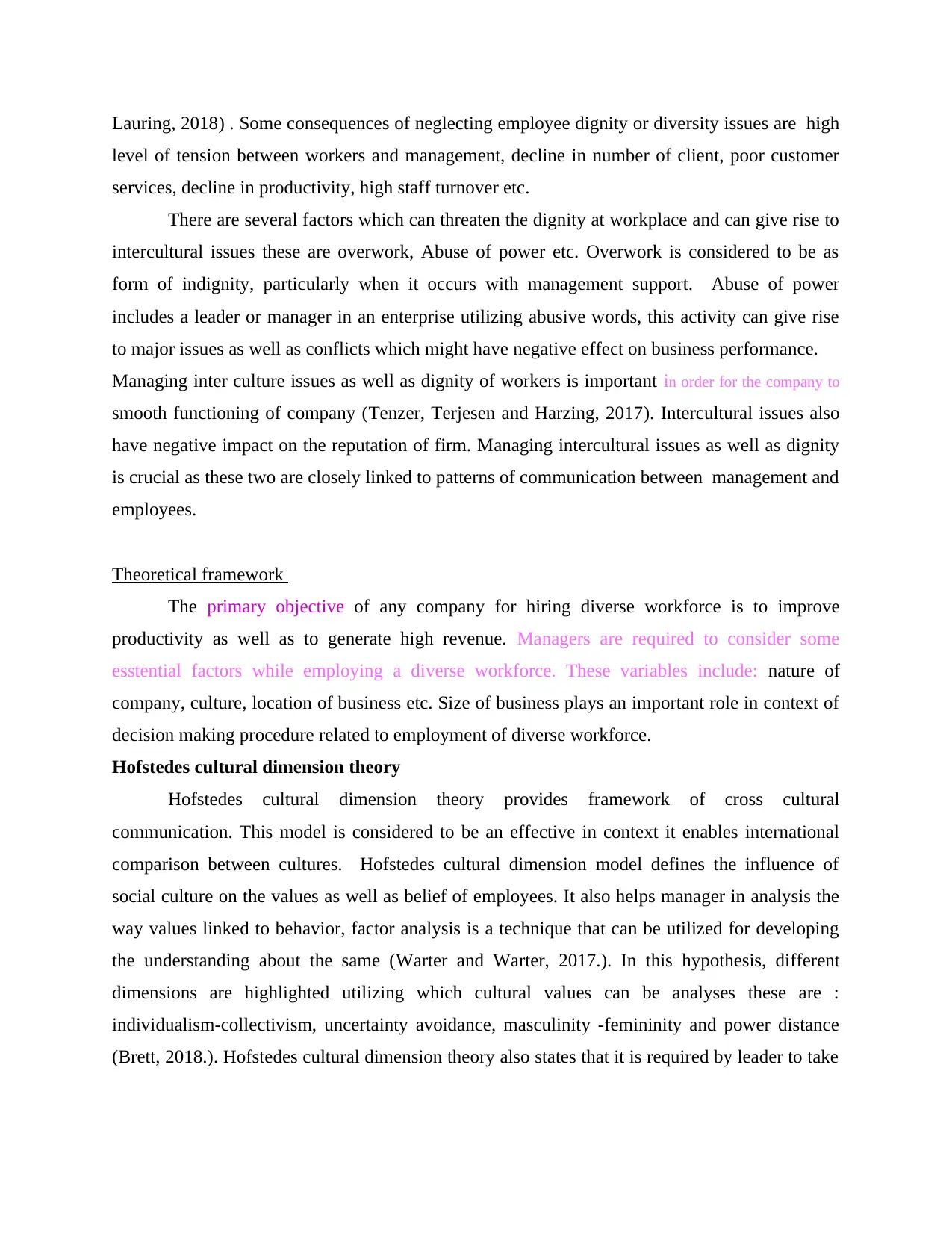
Lauring, 2018) . Some consequences of neglecting employee dignity or diversity issues are high
level of tension between workers and management, decline in number of client, poor customer
services, decline in productivity, high staff turnover etc.
There are several factors which can threaten the dignity at workplace and can give rise to
intercultural issues these are overwork, Abuse of power etc. Overwork is considered to be as
form of indignity, particularly when it occurs with management support. Abuse of power
includes a leader or manager in an enterprise utilizing abusive words, this activity can give rise
to major issues as well as conflicts which might have negative effect on business performance.
Managing inter culture issues as well as dignity of workers is important in order for the company to
smooth functioning of company (Tenzer, Terjesen and Harzing, 2017). Intercultural issues also
have negative impact on the reputation of firm. Managing intercultural issues as well as dignity
is crucial as these two are closely linked to patterns of communication between management and
employees.
Theoretical framework
The primary objective of any company for hiring diverse workforce is to improve
productivity as well as to generate high revenue. Managers are required to consider some
esstential factors while employing a diverse workforce. These variables include: nature of
company, culture, location of business etc. Size of business plays an important role in context of
decision making procedure related to employment of diverse workforce.
Hofstedes cultural dimension theory
Hofstedes cultural dimension theory provides framework of cross cultural
communication. This model is considered to be an effective in context it enables international
comparison between cultures. Hofstedes cultural dimension model defines the influence of
social culture on the values as well as belief of employees. It also helps manager in analysis the
way values linked to behavior, factor analysis is a technique that can be utilized for developing
the understanding about the same (Warter and Warter, 2017.). In this hypothesis, different
dimensions are highlighted utilizing which cultural values can be analyses these are :
individualism-collectivism, uncertainty avoidance, masculinity -femininity and power distance
(Brett, 2018.). Hofstedes cultural dimension theory also states that it is required by leader to take
level of tension between workers and management, decline in number of client, poor customer
services, decline in productivity, high staff turnover etc.
There are several factors which can threaten the dignity at workplace and can give rise to
intercultural issues these are overwork, Abuse of power etc. Overwork is considered to be as
form of indignity, particularly when it occurs with management support. Abuse of power
includes a leader or manager in an enterprise utilizing abusive words, this activity can give rise
to major issues as well as conflicts which might have negative effect on business performance.
Managing inter culture issues as well as dignity of workers is important in order for the company to
smooth functioning of company (Tenzer, Terjesen and Harzing, 2017). Intercultural issues also
have negative impact on the reputation of firm. Managing intercultural issues as well as dignity
is crucial as these two are closely linked to patterns of communication between management and
employees.
Theoretical framework
The primary objective of any company for hiring diverse workforce is to improve
productivity as well as to generate high revenue. Managers are required to consider some
esstential factors while employing a diverse workforce. These variables include: nature of
company, culture, location of business etc. Size of business plays an important role in context of
decision making procedure related to employment of diverse workforce.
Hofstedes cultural dimension theory
Hofstedes cultural dimension theory provides framework of cross cultural
communication. This model is considered to be an effective in context it enables international
comparison between cultures. Hofstedes cultural dimension model defines the influence of
social culture on the values as well as belief of employees. It also helps manager in analysis the
way values linked to behavior, factor analysis is a technique that can be utilized for developing
the understanding about the same (Warter and Warter, 2017.). In this hypothesis, different
dimensions are highlighted utilizing which cultural values can be analyses these are :
individualism-collectivism, uncertainty avoidance, masculinity -femininity and power distance
(Brett, 2018.). Hofstedes cultural dimension theory also states that it is required by leader to take
Paraphrase This Document
Need a fresh take? Get an instant paraphrase of this document with our AI Paraphraser
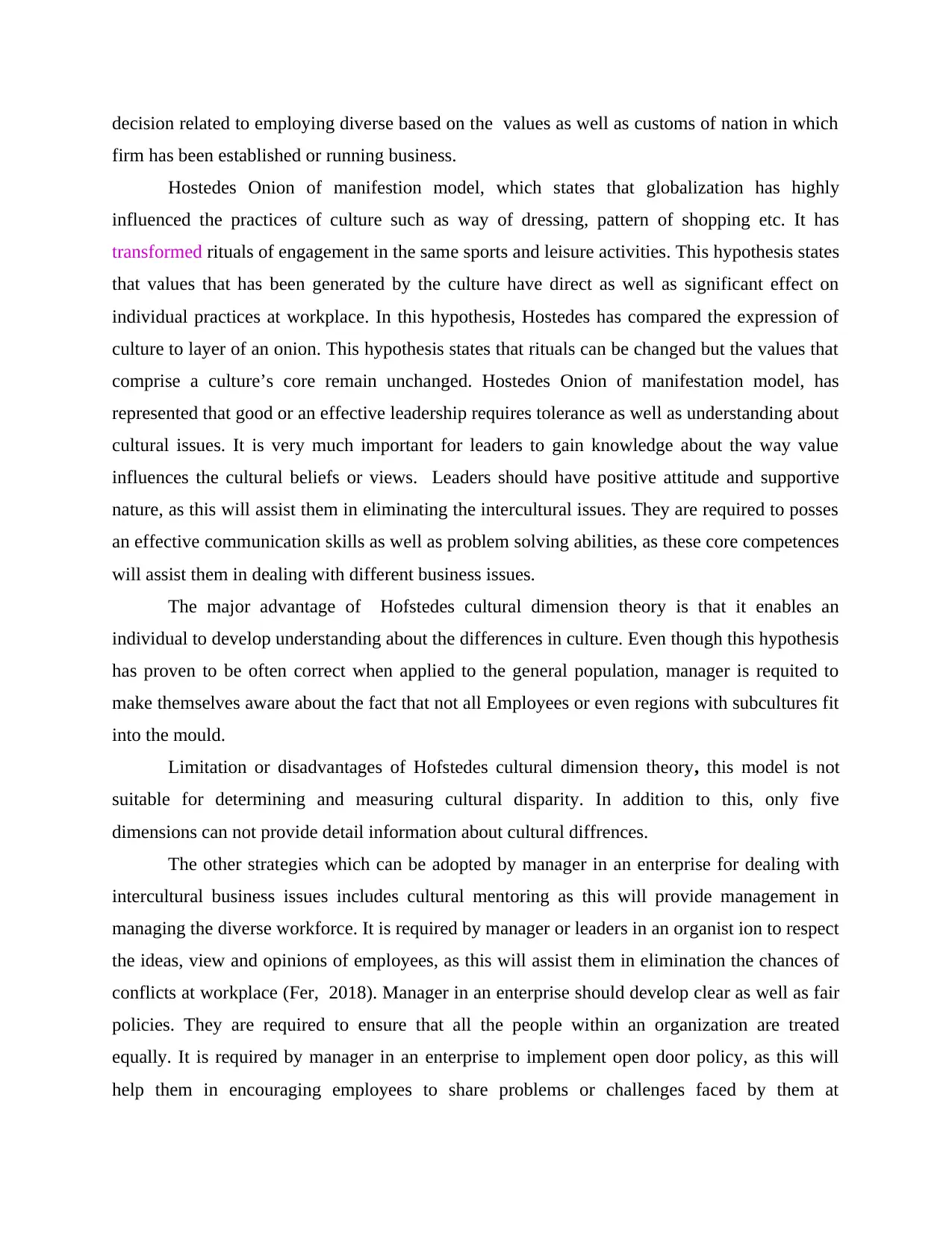
decision related to employing diverse based on the values as well as customs of nation in which
firm has been established or running business.
Hostedes Onion of manifestion model, which states that globalization has highly
influenced the practices of culture such as way of dressing, pattern of shopping etc. It has
transformed rituals of engagement in the same sports and leisure activities. This hypothesis states
that values that has been generated by the culture have direct as well as significant effect on
individual practices at workplace. In this hypothesis, Hostedes has compared the expression of
culture to layer of an onion. This hypothesis states that rituals can be changed but the values that
comprise a culture’s core remain unchanged. Hostedes Onion of manifestation model, has
represented that good or an effective leadership requires tolerance as well as understanding about
cultural issues. It is very much important for leaders to gain knowledge about the way value
influences the cultural beliefs or views. Leaders should have positive attitude and supportive
nature, as this will assist them in eliminating the intercultural issues. They are required to posses
an effective communication skills as well as problem solving abilities, as these core competences
will assist them in dealing with different business issues.
The major advantage of Hofstedes cultural dimension theory is that it enables an
individual to develop understanding about the differences in culture. Even though this hypothesis
has proven to be often correct when applied to the general population, manager is requited to
make themselves aware about the fact that not all Employees or even regions with subcultures fit
into the mould.
Limitation or disadvantages of Hofstedes cultural dimension theory, this model is not
suitable for determining and measuring cultural disparity. In addition to this, only five
dimensions can not provide detail information about cultural diffrences.
The other strategies which can be adopted by manager in an enterprise for dealing with
intercultural business issues includes cultural mentoring as this will provide management in
managing the diverse workforce. It is required by manager or leaders in an organist ion to respect
the ideas, view and opinions of employees, as this will assist them in elimination the chances of
conflicts at workplace (Fer, 2018). Manager in an enterprise should develop clear as well as fair
policies. They are required to ensure that all the people within an organization are treated
equally. It is required by manager in an enterprise to implement open door policy, as this will
help them in encouraging employees to share problems or challenges faced by them at
firm has been established or running business.
Hostedes Onion of manifestion model, which states that globalization has highly
influenced the practices of culture such as way of dressing, pattern of shopping etc. It has
transformed rituals of engagement in the same sports and leisure activities. This hypothesis states
that values that has been generated by the culture have direct as well as significant effect on
individual practices at workplace. In this hypothesis, Hostedes has compared the expression of
culture to layer of an onion. This hypothesis states that rituals can be changed but the values that
comprise a culture’s core remain unchanged. Hostedes Onion of manifestation model, has
represented that good or an effective leadership requires tolerance as well as understanding about
cultural issues. It is very much important for leaders to gain knowledge about the way value
influences the cultural beliefs or views. Leaders should have positive attitude and supportive
nature, as this will assist them in eliminating the intercultural issues. They are required to posses
an effective communication skills as well as problem solving abilities, as these core competences
will assist them in dealing with different business issues.
The major advantage of Hofstedes cultural dimension theory is that it enables an
individual to develop understanding about the differences in culture. Even though this hypothesis
has proven to be often correct when applied to the general population, manager is requited to
make themselves aware about the fact that not all Employees or even regions with subcultures fit
into the mould.
Limitation or disadvantages of Hofstedes cultural dimension theory, this model is not
suitable for determining and measuring cultural disparity. In addition to this, only five
dimensions can not provide detail information about cultural diffrences.
The other strategies which can be adopted by manager in an enterprise for dealing with
intercultural business issues includes cultural mentoring as this will provide management in
managing the diverse workforce. It is required by manager or leaders in an organist ion to respect
the ideas, view and opinions of employees, as this will assist them in elimination the chances of
conflicts at workplace (Fer, 2018). Manager in an enterprise should develop clear as well as fair
policies. They are required to ensure that all the people within an organization are treated
equally. It is required by manager in an enterprise to implement open door policy, as this will
help them in encouraging employees to share problems or challenges faced by them at
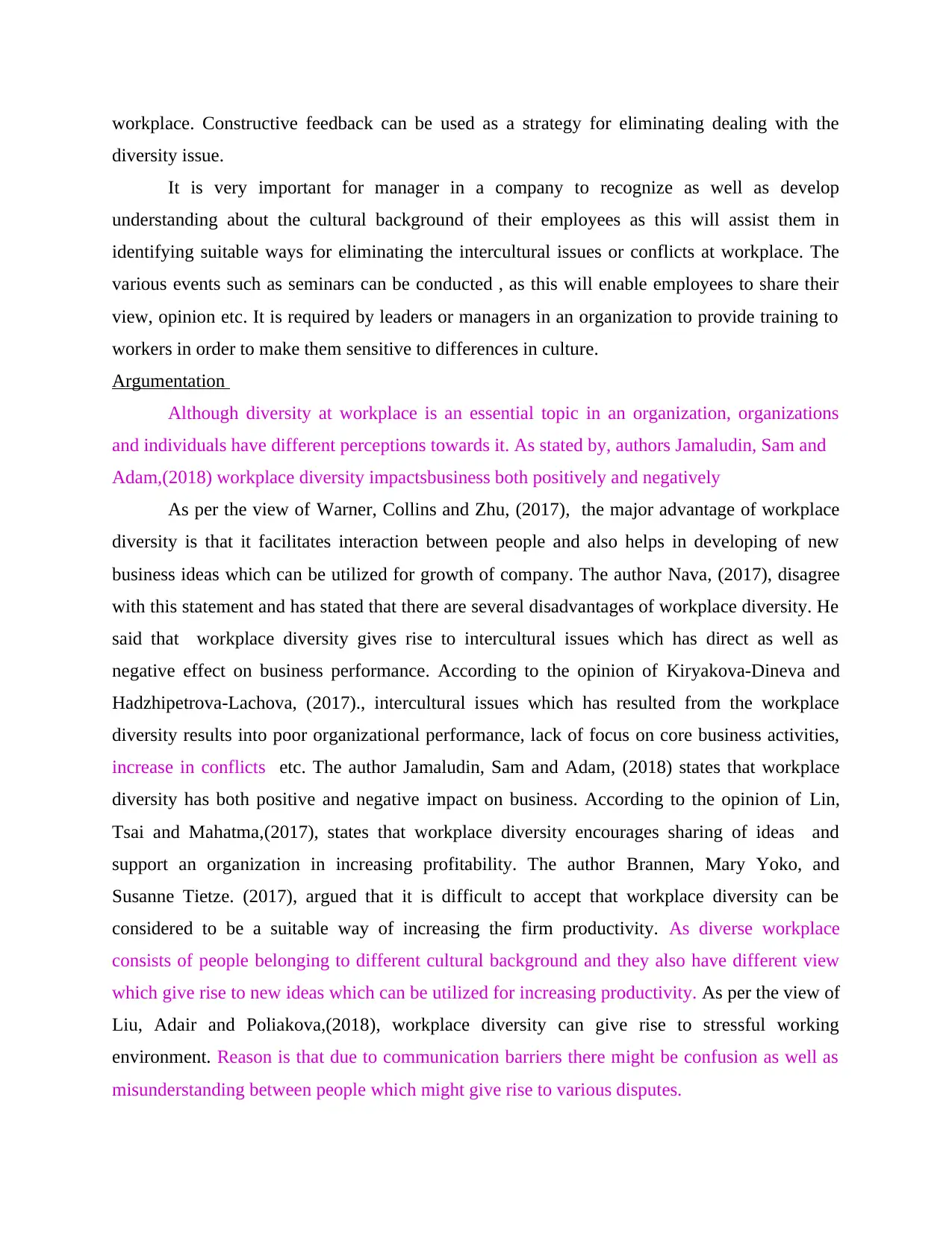
workplace. Constructive feedback can be used as a strategy for eliminating dealing with the
diversity issue.
It is very important for manager in a company to recognize as well as develop
understanding about the cultural background of their employees as this will assist them in
identifying suitable ways for eliminating the intercultural issues or conflicts at workplace. The
various events such as seminars can be conducted , as this will enable employees to share their
view, opinion etc. It is required by leaders or managers in an organization to provide training to
workers in order to make them sensitive to differences in culture.
Argumentation
Although diversity at workplace is an essential topic in an organization, organizations
and individuals have different perceptions towards it. As stated by, authors Jamaludin, Sam and
Adam,(2018) workplace diversity impactsbusiness both positively and negatively
As per the view of Warner, Collins and Zhu, (2017), the major advantage of workplace
diversity is that it facilitates interaction between people and also helps in developing of new
business ideas which can be utilized for growth of company. The author Nava, (2017), disagree
with this statement and has stated that there are several disadvantages of workplace diversity. He
said that workplace diversity gives rise to intercultural issues which has direct as well as
negative effect on business performance. According to the opinion of Kiryakova-Dineva and
Hadzhipetrova-Lachova, (2017)., intercultural issues which has resulted from the workplace
diversity results into poor organizational performance, lack of focus on core business activities,
increase in conflicts etc. The author Jamaludin, Sam and Adam, (2018) states that workplace
diversity has both positive and negative impact on business. According to the opinion of Lin,
Tsai and Mahatma,(2017), states that workplace diversity encourages sharing of ideas and
support an organization in increasing profitability. The author Brannen, Mary Yoko, and
Susanne Tietze. (2017), argued that it is difficult to accept that workplace diversity can be
considered to be a suitable way of increasing the firm productivity. As diverse workplace
consists of people belonging to different cultural background and they also have different view
which give rise to new ideas which can be utilized for increasing productivity. As per the view of
Liu, Adair and Poliakova,(2018), workplace diversity can give rise to stressful working
environment. Reason is that due to communication barriers there might be confusion as well as
misunderstanding between people which might give rise to various disputes.
diversity issue.
It is very important for manager in a company to recognize as well as develop
understanding about the cultural background of their employees as this will assist them in
identifying suitable ways for eliminating the intercultural issues or conflicts at workplace. The
various events such as seminars can be conducted , as this will enable employees to share their
view, opinion etc. It is required by leaders or managers in an organization to provide training to
workers in order to make them sensitive to differences in culture.
Argumentation
Although diversity at workplace is an essential topic in an organization, organizations
and individuals have different perceptions towards it. As stated by, authors Jamaludin, Sam and
Adam,(2018) workplace diversity impactsbusiness both positively and negatively
As per the view of Warner, Collins and Zhu, (2017), the major advantage of workplace
diversity is that it facilitates interaction between people and also helps in developing of new
business ideas which can be utilized for growth of company. The author Nava, (2017), disagree
with this statement and has stated that there are several disadvantages of workplace diversity. He
said that workplace diversity gives rise to intercultural issues which has direct as well as
negative effect on business performance. According to the opinion of Kiryakova-Dineva and
Hadzhipetrova-Lachova, (2017)., intercultural issues which has resulted from the workplace
diversity results into poor organizational performance, lack of focus on core business activities,
increase in conflicts etc. The author Jamaludin, Sam and Adam, (2018) states that workplace
diversity has both positive and negative impact on business. According to the opinion of Lin,
Tsai and Mahatma,(2017), states that workplace diversity encourages sharing of ideas and
support an organization in increasing profitability. The author Brannen, Mary Yoko, and
Susanne Tietze. (2017), argued that it is difficult to accept that workplace diversity can be
considered to be a suitable way of increasing the firm productivity. As diverse workplace
consists of people belonging to different cultural background and they also have different view
which give rise to new ideas which can be utilized for increasing productivity. As per the view of
Liu, Adair and Poliakova,(2018), workplace diversity can give rise to stressful working
environment. Reason is that due to communication barriers there might be confusion as well as
misunderstanding between people which might give rise to various disputes.
⊘ This is a preview!⊘
Do you want full access?
Subscribe today to unlock all pages.

Trusted by 1+ million students worldwide
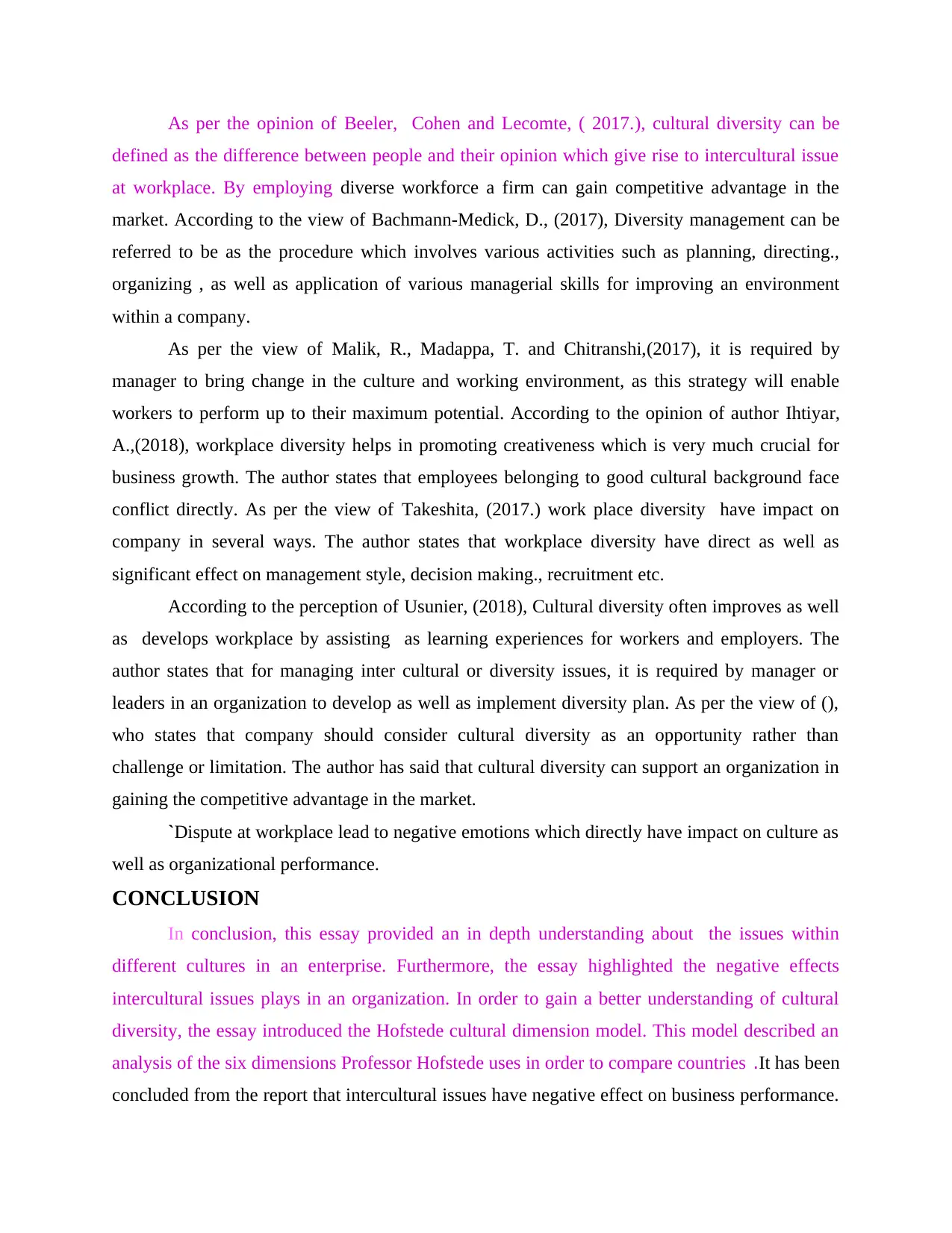
As per the opinion of Beeler, Cohen and Lecomte, ( 2017.), cultural diversity can be
defined as the difference between people and their opinion which give rise to intercultural issue
at workplace. By employing diverse workforce a firm can gain competitive advantage in the
market. According to the view of Bachmann-Medick, D., (2017), Diversity management can be
referred to be as the procedure which involves various activities such as planning, directing.,
organizing , as well as application of various managerial skills for improving an environment
within a company.
As per the view of Malik, R., Madappa, T. and Chitranshi,(2017), it is required by
manager to bring change in the culture and working environment, as this strategy will enable
workers to perform up to their maximum potential. According to the opinion of author Ihtiyar,
A.,(2018), workplace diversity helps in promoting creativeness which is very much crucial for
business growth. The author states that employees belonging to good cultural background face
conflict directly. As per the view of Takeshita, (2017.) work place diversity have impact on
company in several ways. The author states that workplace diversity have direct as well as
significant effect on management style, decision making., recruitment etc.
According to the perception of Usunier, (2018), Cultural diversity often improves as well
as develops workplace by assisting as learning experiences for workers and employers. The
author states that for managing inter cultural or diversity issues, it is required by manager or
leaders in an organization to develop as well as implement diversity plan. As per the view of (),
who states that company should consider cultural diversity as an opportunity rather than
challenge or limitation. The author has said that cultural diversity can support an organization in
gaining the competitive advantage in the market.
`Dispute at workplace lead to negative emotions which directly have impact on culture as
well as organizational performance.
CONCLUSION
In conclusion, this essay provided an in depth understanding about the issues within
different cultures in an enterprise. Furthermore, the essay highlighted the negative effects
intercultural issues plays in an organization. In order to gain a better understanding of cultural
diversity, the essay introduced the Hofstede cultural dimension model. This model described an
analysis of the six dimensions Professor Hofstede uses in order to compare countries .It has been
concluded from the report that intercultural issues have negative effect on business performance.
defined as the difference between people and their opinion which give rise to intercultural issue
at workplace. By employing diverse workforce a firm can gain competitive advantage in the
market. According to the view of Bachmann-Medick, D., (2017), Diversity management can be
referred to be as the procedure which involves various activities such as planning, directing.,
organizing , as well as application of various managerial skills for improving an environment
within a company.
As per the view of Malik, R., Madappa, T. and Chitranshi,(2017), it is required by
manager to bring change in the culture and working environment, as this strategy will enable
workers to perform up to their maximum potential. According to the opinion of author Ihtiyar,
A.,(2018), workplace diversity helps in promoting creativeness which is very much crucial for
business growth. The author states that employees belonging to good cultural background face
conflict directly. As per the view of Takeshita, (2017.) work place diversity have impact on
company in several ways. The author states that workplace diversity have direct as well as
significant effect on management style, decision making., recruitment etc.
According to the perception of Usunier, (2018), Cultural diversity often improves as well
as develops workplace by assisting as learning experiences for workers and employers. The
author states that for managing inter cultural or diversity issues, it is required by manager or
leaders in an organization to develop as well as implement diversity plan. As per the view of (),
who states that company should consider cultural diversity as an opportunity rather than
challenge or limitation. The author has said that cultural diversity can support an organization in
gaining the competitive advantage in the market.
`Dispute at workplace lead to negative emotions which directly have impact on culture as
well as organizational performance.
CONCLUSION
In conclusion, this essay provided an in depth understanding about the issues within
different cultures in an enterprise. Furthermore, the essay highlighted the negative effects
intercultural issues plays in an organization. In order to gain a better understanding of cultural
diversity, the essay introduced the Hofstede cultural dimension model. This model described an
analysis of the six dimensions Professor Hofstede uses in order to compare countries .It has been
concluded from the report that intercultural issues have negative effect on business performance.
Paraphrase This Document
Need a fresh take? Get an instant paraphrase of this document with our AI Paraphraser
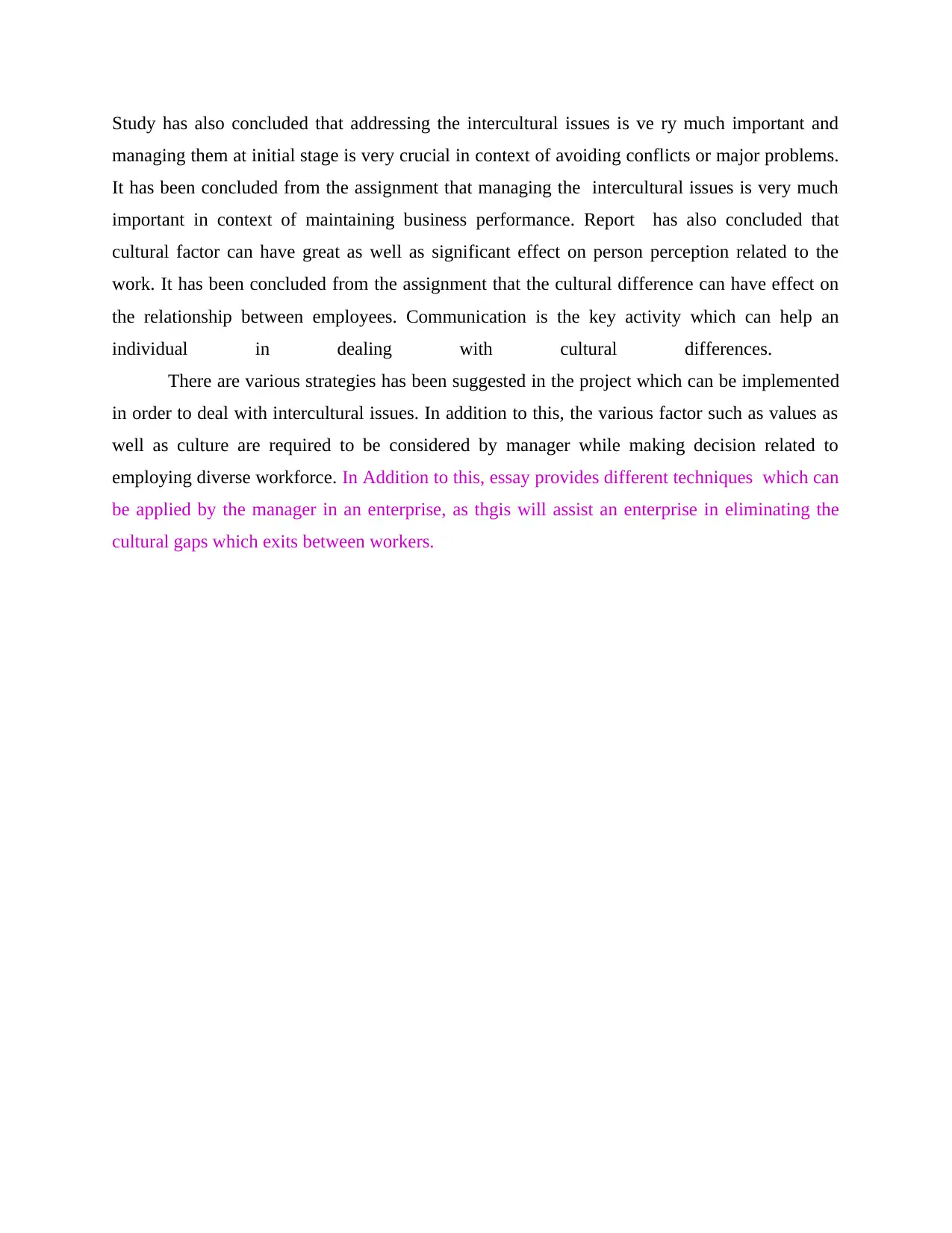
Study has also concluded that addressing the intercultural issues is ve ry much important and
managing them at initial stage is very crucial in context of avoiding conflicts or major problems.
It has been concluded from the assignment that managing the intercultural issues is very much
important in context of maintaining business performance. Report has also concluded that
cultural factor can have great as well as significant effect on person perception related to the
work. It has been concluded from the assignment that the cultural difference can have effect on
the relationship between employees. Communication is the key activity which can help an
individual in dealing with cultural differences.
There are various strategies has been suggested in the project which can be implemented
in order to deal with intercultural issues. In addition to this, the various factor such as values as
well as culture are required to be considered by manager while making decision related to
employing diverse workforce. In Addition to this, essay provides different techniques which can
be applied by the manager in an enterprise, as thgis will assist an enterprise in eliminating the
cultural gaps which exits between workers.
managing them at initial stage is very crucial in context of avoiding conflicts or major problems.
It has been concluded from the assignment that managing the intercultural issues is very much
important in context of maintaining business performance. Report has also concluded that
cultural factor can have great as well as significant effect on person perception related to the
work. It has been concluded from the assignment that the cultural difference can have effect on
the relationship between employees. Communication is the key activity which can help an
individual in dealing with cultural differences.
There are various strategies has been suggested in the project which can be implemented
in order to deal with intercultural issues. In addition to this, the various factor such as values as
well as culture are required to be considered by manager while making decision related to
employing diverse workforce. In Addition to this, essay provides different techniques which can
be applied by the manager in an enterprise, as thgis will assist an enterprise in eliminating the
cultural gaps which exits between workers.
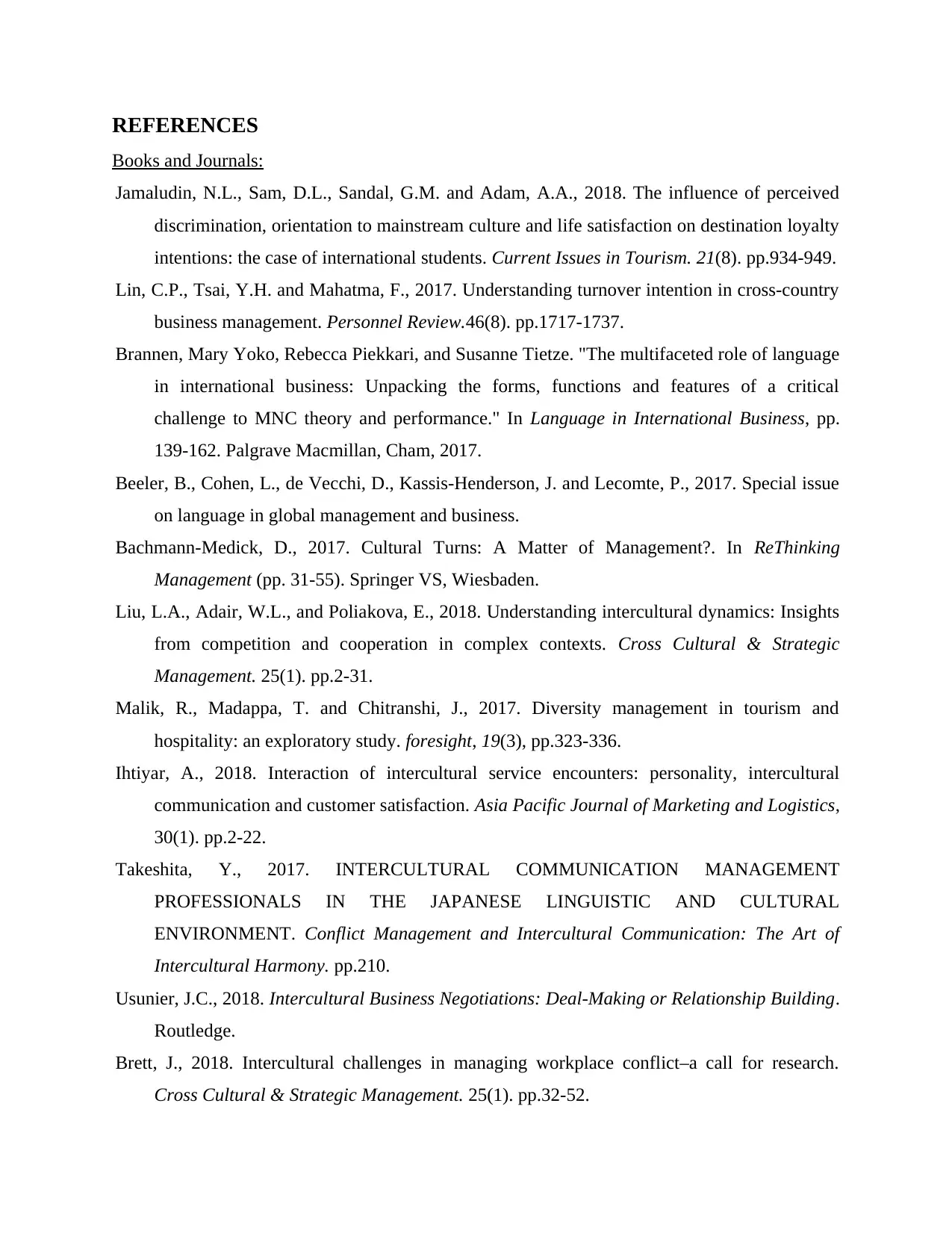
REFERENCES
Books and Journals:
Jamaludin, N.L., Sam, D.L., Sandal, G.M. and Adam, A.A., 2018. The influence of perceived
discrimination, orientation to mainstream culture and life satisfaction on destination loyalty
intentions: the case of international students. Current Issues in Tourism. 21(8). pp.934-949.
Lin, C.P., Tsai, Y.H. and Mahatma, F., 2017. Understanding turnover intention in cross-country
business management. Personnel Review.46(8). pp.1717-1737.
Brannen, Mary Yoko, Rebecca Piekkari, and Susanne Tietze. "The multifaceted role of language
in international business: Unpacking the forms, functions and features of a critical
challenge to MNC theory and performance." In Language in International Business, pp.
139-162. Palgrave Macmillan, Cham, 2017.
Beeler, B., Cohen, L., de Vecchi, D., Kassis-Henderson, J. and Lecomte, P., 2017. Special issue
on language in global management and business.
Bachmann-Medick, D., 2017. Cultural Turns: A Matter of Management?. In ReThinking
Management (pp. 31-55). Springer VS, Wiesbaden.
Liu, L.A., Adair, W.L., and Poliakova, E., 2018. Understanding intercultural dynamics: Insights
from competition and cooperation in complex contexts. Cross Cultural & Strategic
Management. 25(1). pp.2-31.
Malik, R., Madappa, T. and Chitranshi, J., 2017. Diversity management in tourism and
hospitality: an exploratory study. foresight, 19(3), pp.323-336.
Ihtiyar, A., 2018. Interaction of intercultural service encounters: personality, intercultural
communication and customer satisfaction. Asia Pacific Journal of Marketing and Logistics,
30(1). pp.2-22.
Takeshita, Y., 2017. INTERCULTURAL COMMUNICATION MANAGEMENT
PROFESSIONALS IN THE JAPANESE LINGUISTIC AND CULTURAL
ENVIRONMENT. Conflict Management and Intercultural Communication: The Art of
Intercultural Harmony. pp.210.
Usunier, J.C., 2018. Intercultural Business Negotiations: Deal-Making or Relationship Building.
Routledge.
Brett, J., 2018. Intercultural challenges in managing workplace conflict–a call for research.
Cross Cultural & Strategic Management. 25(1). pp.32-52.
Books and Journals:
Jamaludin, N.L., Sam, D.L., Sandal, G.M. and Adam, A.A., 2018. The influence of perceived
discrimination, orientation to mainstream culture and life satisfaction on destination loyalty
intentions: the case of international students. Current Issues in Tourism. 21(8). pp.934-949.
Lin, C.P., Tsai, Y.H. and Mahatma, F., 2017. Understanding turnover intention in cross-country
business management. Personnel Review.46(8). pp.1717-1737.
Brannen, Mary Yoko, Rebecca Piekkari, and Susanne Tietze. "The multifaceted role of language
in international business: Unpacking the forms, functions and features of a critical
challenge to MNC theory and performance." In Language in International Business, pp.
139-162. Palgrave Macmillan, Cham, 2017.
Beeler, B., Cohen, L., de Vecchi, D., Kassis-Henderson, J. and Lecomte, P., 2017. Special issue
on language in global management and business.
Bachmann-Medick, D., 2017. Cultural Turns: A Matter of Management?. In ReThinking
Management (pp. 31-55). Springer VS, Wiesbaden.
Liu, L.A., Adair, W.L., and Poliakova, E., 2018. Understanding intercultural dynamics: Insights
from competition and cooperation in complex contexts. Cross Cultural & Strategic
Management. 25(1). pp.2-31.
Malik, R., Madappa, T. and Chitranshi, J., 2017. Diversity management in tourism and
hospitality: an exploratory study. foresight, 19(3), pp.323-336.
Ihtiyar, A., 2018. Interaction of intercultural service encounters: personality, intercultural
communication and customer satisfaction. Asia Pacific Journal of Marketing and Logistics,
30(1). pp.2-22.
Takeshita, Y., 2017. INTERCULTURAL COMMUNICATION MANAGEMENT
PROFESSIONALS IN THE JAPANESE LINGUISTIC AND CULTURAL
ENVIRONMENT. Conflict Management and Intercultural Communication: The Art of
Intercultural Harmony. pp.210.
Usunier, J.C., 2018. Intercultural Business Negotiations: Deal-Making or Relationship Building.
Routledge.
Brett, J., 2018. Intercultural challenges in managing workplace conflict–a call for research.
Cross Cultural & Strategic Management. 25(1). pp.32-52.
⊘ This is a preview!⊘
Do you want full access?
Subscribe today to unlock all pages.

Trusted by 1+ million students worldwide
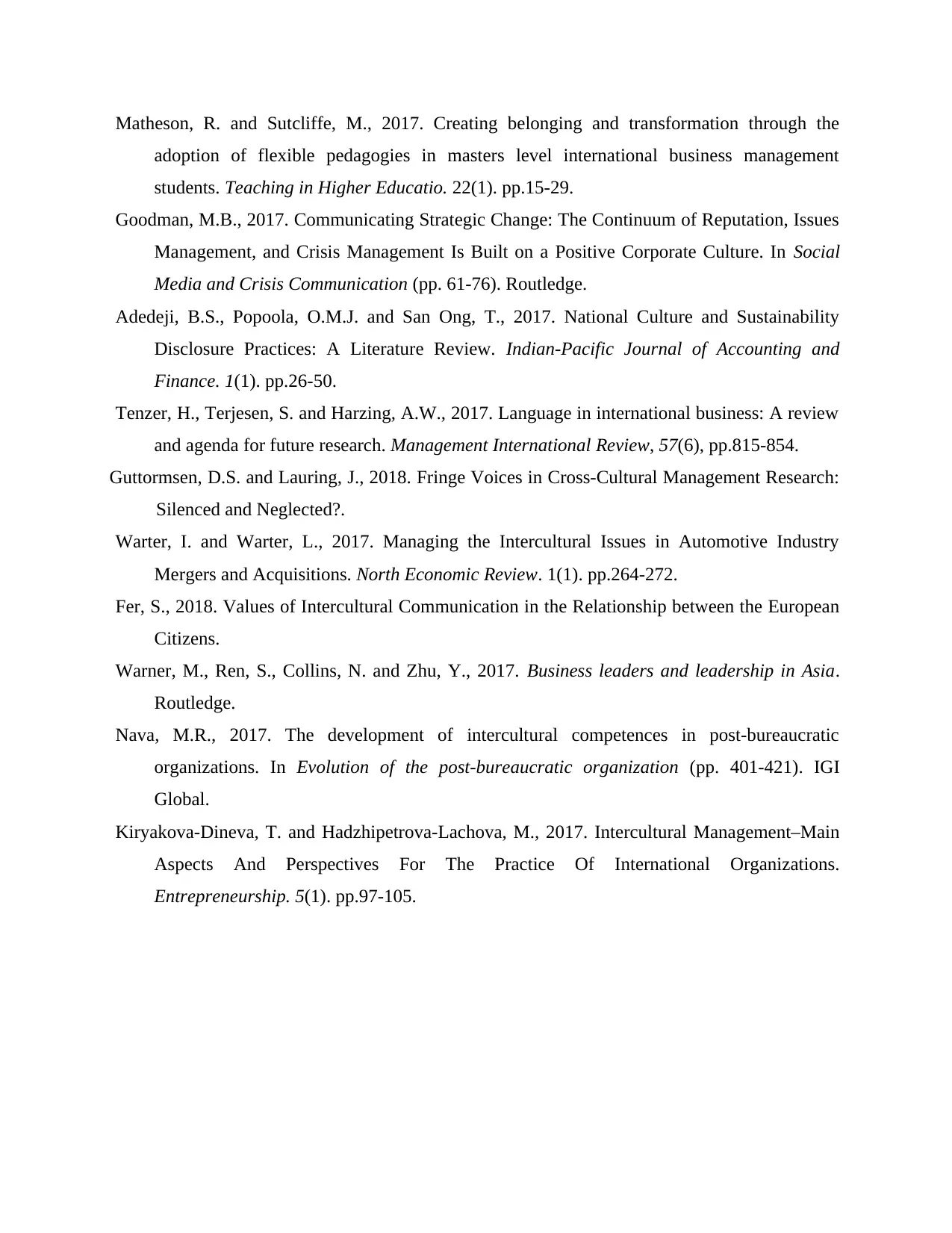
Matheson, R. and Sutcliffe, M., 2017. Creating belonging and transformation through the
adoption of flexible pedagogies in masters level international business management
students. Teaching in Higher Educatio. 22(1). pp.15-29.
Goodman, M.B., 2017. Communicating Strategic Change: The Continuum of Reputation, Issues
Management, and Crisis Management Is Built on a Positive Corporate Culture. In Social
Media and Crisis Communication (pp. 61-76). Routledge.
Adedeji, B.S., Popoola, O.M.J. and San Ong, T., 2017. National Culture and Sustainability
Disclosure Practices: A Literature Review. Indian-Pacific Journal of Accounting and
Finance. 1(1). pp.26-50.
Tenzer, H., Terjesen, S. and Harzing, A.W., 2017. Language in international business: A review
and agenda for future research. Management International Review, 57(6), pp.815-854.
Guttormsen, D.S. and Lauring, J., 2018. Fringe Voices in Cross-Cultural Management Research:
Silenced and Neglected?.
Warter, I. and Warter, L., 2017. Managing the Intercultural Issues in Automotive Industry
Mergers and Acquisitions. North Economic Review. 1(1). pp.264-272.
Fer, S., 2018. Values of Intercultural Communication in the Relationship between the European
Citizens.
Warner, M., Ren, S., Collins, N. and Zhu, Y., 2017. Business leaders and leadership in Asia.
Routledge.
Nava, M.R., 2017. The development of intercultural competences in post-bureaucratic
organizations. In Evolution of the post-bureaucratic organization (pp. 401-421). IGI
Global.
Kiryakova-Dineva, T. and Hadzhipetrova-Lachova, M., 2017. Intercultural Management–Main
Aspects And Perspectives For The Practice Of International Organizations.
Entrepreneurship. 5(1). pp.97-105.
adoption of flexible pedagogies in masters level international business management
students. Teaching in Higher Educatio. 22(1). pp.15-29.
Goodman, M.B., 2017. Communicating Strategic Change: The Continuum of Reputation, Issues
Management, and Crisis Management Is Built on a Positive Corporate Culture. In Social
Media and Crisis Communication (pp. 61-76). Routledge.
Adedeji, B.S., Popoola, O.M.J. and San Ong, T., 2017. National Culture and Sustainability
Disclosure Practices: A Literature Review. Indian-Pacific Journal of Accounting and
Finance. 1(1). pp.26-50.
Tenzer, H., Terjesen, S. and Harzing, A.W., 2017. Language in international business: A review
and agenda for future research. Management International Review, 57(6), pp.815-854.
Guttormsen, D.S. and Lauring, J., 2018. Fringe Voices in Cross-Cultural Management Research:
Silenced and Neglected?.
Warter, I. and Warter, L., 2017. Managing the Intercultural Issues in Automotive Industry
Mergers and Acquisitions. North Economic Review. 1(1). pp.264-272.
Fer, S., 2018. Values of Intercultural Communication in the Relationship between the European
Citizens.
Warner, M., Ren, S., Collins, N. and Zhu, Y., 2017. Business leaders and leadership in Asia.
Routledge.
Nava, M.R., 2017. The development of intercultural competences in post-bureaucratic
organizations. In Evolution of the post-bureaucratic organization (pp. 401-421). IGI
Global.
Kiryakova-Dineva, T. and Hadzhipetrova-Lachova, M., 2017. Intercultural Management–Main
Aspects And Perspectives For The Practice Of International Organizations.
Entrepreneurship. 5(1). pp.97-105.
1 out of 10
Related Documents
Your All-in-One AI-Powered Toolkit for Academic Success.
+13062052269
info@desklib.com
Available 24*7 on WhatsApp / Email
![[object Object]](/_next/static/media/star-bottom.7253800d.svg)
Unlock your academic potential
Copyright © 2020–2025 A2Z Services. All Rights Reserved. Developed and managed by ZUCOL.





